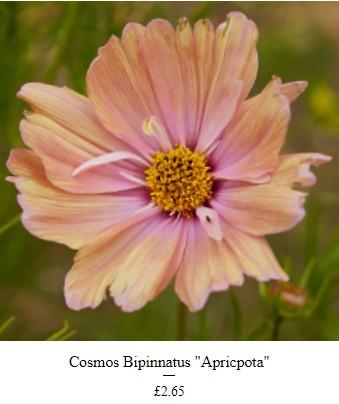Mother’s Day Collections
With scented Sweepeas and our favourite annuals



With scented Sweepeas and our favourite annuals


There’s nothing more exciting than a new business, or a new website launch……….. Well actually there’s seeds, growing our own cut flowers and a beautiful garden full of flowery delights! And I am so excited to bring this little business to life at last.
The website is jam packed full of hints, tips and helpful advise for how to sow, grow and harvest your own flowers which I hope our readers will find helpful. The shop has been filled with all of my favourite seeds most of which I have grown over the years either for cut flowers, containers or my garden borders and I hope that we can inspire everyone to have a go at growing their own fresh cut flowers. We’ll guide you all the way with how to guides for seed sowing, propagation and planting whether you are at the beginning of your floral journey or just want to learn more.

How to Order











 Beautiful whorl shaped blooms of pale purple and green, much loved by bees and an unusual bouquet filler.
Beautiful whorl shaped blooms of pale purple and green, much loved by bees and an unusual bouquet filler.






























With a wealth of botanical expertise and a commitment to environmental stewardship, UK suppliers offer a diverse range of high-quality plants and seeds suited to various climates and soil conditions. We prioritize collaboration with local growers to cultivate as many of our seeds as possible, spanning a diverse array of plants, championing the beauty and bounty of British flora.
This partnership not only ensures the freshness and quality of our products but also promotes sustainability and supports local agricultural communities. The breadth of range available through our partners is extensive, showcasing the rich tapestry of flora that thrives across the country from Larkspur to Lupins and Cornflower to Scabious. With growers situated in various locations throughout the UK, we are able to offer customers a wide selection of seeds supporting out flowers farmers, fostering regional diversity and resilience within our supply chain and also reducing the carbon footprint associated with long-distance transportation, promoting a greener approach to gardening and agriculture.
We are actively working with our flower farmers to be able to support us as we grow, this takes time and so to ensure that we get continuity of supply we also offer imported seeds for sale alongside our home grown range. Within the product ordering pages it is made clear at the point of purchase which seeds are UK and which are from further afield.
If you are a British farmer and would like to become a supplier then please do get in touch.
thehamshireseedco@outlook.com





























Timing : Sown in late Summer/early autumn, September here in the UK, they will germinate quickly - within a few weeks. You may need a little bottom heat but I have successfully germinated then without it.
Compost: Use a sterile soil or seed compost as they are very prone to damping off. This will ensure that there are limited nutrients for fungi & bacteria to grow.
Quantity: Sow thinly - the seeds are microscopic and can be easily over crowded so sow seeds as thinly as possible to give them the room they need to grow and give good air circulation.
Trays: I sow my poppies in flat trays as I like to save as much space as possible. You can also sow then straight into cell trays if you have the space.
Cover: They need light to germinate so a light cover of vermiculate is all that is needed. This is to stop the seeds from being washed away.
Watering: Water the soil BEFORE you sow the seeds, which stops the seeds from being washed away. Keep the soil most until germination then allow it to dry out a little between waterings otherwise the seedlings will suffer from damping off.
Potting on: They are slow growers and will stay quite small for a very long time, however pot them on into small cell trays as soon as they are big enough to handle and have developed true leaves.
Watering: Do not water the seedlings from overhead. They are still very delicate at this stage and will get easily damaged. Instead water from below and allow then to dry out a little between waterings to prevent damping off.
Overwintering: As the name kind of suggests Icelandic poppies like cool conditions, they can easily cope with a little frost so they can be grown on in an unheated greenhouse or coldframe for a few weeks until they are big enough to go into the ground. I often wait until late winter to plant them out into the ground and within a month or two the weather starts to warm a little and they will start to grow once more.
Planting out: An unheated greenhouse or polytunnel is ideal. They don't like heat so will happily flower early in the season. You can also plant them straight out into the ground and cover then with a low tunnel just for a little Snow and frost protection.
Cutting & Conditioning: Cut poppies in the cracking bud stage, before they unfurl. You will see just a tiny hint of coloured petal through a crack in the fury bud . I go out early in the morning to catch them, otherwise they will pop open in the morning sunshine. This prevents pollination so they will last longer in the vase, you can also sear the ends in boiling water and they will last around 5 days on the vase.
